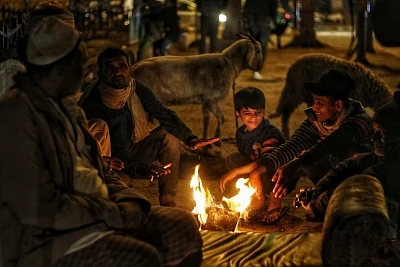The beginning of this week came with below normal temperatures for Mumbai bringing down the mean minimum temperature for January to 17.3 degree Celsius, and the forecast tells us that this is likely to continue for the rest of this week. The lowest was recorded at 14.4 degree celsius in Santacruz on Wednesday.
North India, which is habituated to cold winters has also been experiencing a severe cold wave. But this rekindled the long standing Mumbai vs Delhi banter on social media, and 'memesters' are having a gala time.
Click here to see all these hot memes.
States in north including Delhi, Punjab, Haryana, Madhya Pradesh and Rajasthan are going through a severe cold winters with temperatures plunging to freezing 2 to 3 degree celsius in some areas. Two more such waves are expected till January 18, post which it will move to the western Himalayan regions leading to some rainfall.
Warnings for the severe cold waves have been issued in several northern states.
What is a Cold Wave?
A cold wave is different for the plains and the mountains. According to the Indian Meterological Department (IMD) if the temperature goes below 10 degree and minimum temperature is at 4.5 degree, it is a cold wave for the plains. The criteria for hills if 0 degree. If the temperature is 6.4 degree below normal or down to 2 degree, it is a severe called wave in the plains.
The IMD calls it “a condition of air temperature which becomes fatal to the human body when exposed.”
Cold waves caused 152 deaths in India in 2020. This year the country saw 99 days of cold waves, according to IMD.
But Why is it So Cold?
Short Answer: Strong streams of western disturbances running through the northern belt are causing this.
Complex Answer: La Nina
“What brings cold to the region, is the unabated north-westerly winds which bring chilly winds from higher latitude to Indo-Gangetic plains. However, passage of back-to-back western disturbances tend to change the wind direction from cold north-westerlies to warm and humid easterlies. However, with La Niña in place, we expect less amount of winter rains and thus, icy cold winds would continue to blow over Northwest India uninterruptedly, bringing down the temperatures.”G P Sharma, President- Meteorology and Climate Change, Skymet Weather.
What is La Nina?
La Nina is a natural phenomenon, which has been triggered by climate change. The worst affected by it is often the Indo-Gangetic Plains (IGP) which cities like Amritsar, Chandigarh, Agra, Kanpur, Moradabad, Varanasi, Lucknow, Patna and Gaya, and many others.
La Niña means Little Girl in Spanish. During La Niña events, trade winds are stronger than usual, pushing more warm water toward Asia. During a La Niña year, winter temperatures are warmer than normal in the South and cooler than normal in the North.
La Nina has made an appearance for the second consecutive year in India.Climate Change to enhance La Niña impact,
“La Niña strengthens the south-westerly jet, which is responsible for bringing the Winter season over North India. It would translate into intermittent waves of extremely cold weather throughout the season. Also, the cyclonic circulations would be more marked and would have the probability to penetrate deeper into Northwest India. With this, we can expect a series of intense cold waves, record low temperatures and chilly winds."Professor A P Dimri, School of Environmental Science, Jawaharlal Nehru University.
Climate has enhanced the impacts of La Niña, which is otherwise a natural phenomenon. On one hand it is causing severe cold waves, while on the other it has led to less than normal winter rainfall in northern states and less than normal snowfall in western Himalayas.
Extreme La Niña events may increase in frequency from about one every 20 years to one every 10 years by the end of the 21st century under aggressive greenhouse gas emission scenarios, say reports.
